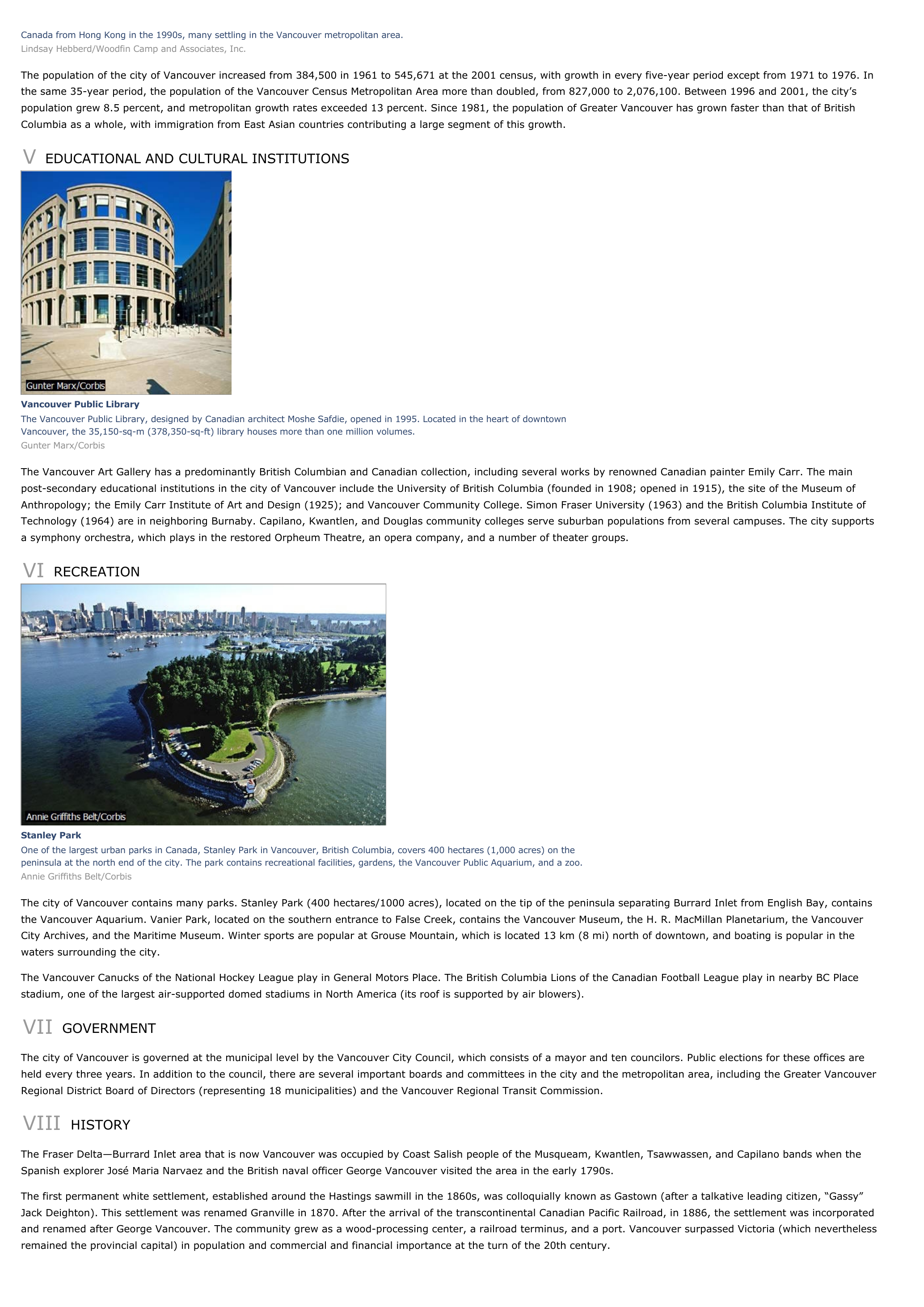Vancouver (British Columbia) - geography.
Publié le 26/05/2013
Extrait du document
«
Canada from Hong Kong in the 1990s, many settling in the Vancouver metropolitan area.Lindsay Hebberd/Woodfin Camp and Associates, Inc.
The population of the city of Vancouver increased from 384,500 in 1961 to 545,671 at the 2001 census, with growth in every five-year period except from 1971 to 1976.
Inthe same 35-year period, the population of the Vancouver Census Metropolitan Area more than doubled, from 827,000 to 2,076,100.
Between 1996 and 2001, the city’spopulation grew 8.5 percent, and metropolitan growth rates exceeded 13 percent.
Since 1981, the population of Greater Vancouver has grown faster than that of BritishColumbia as a whole, with immigration from East Asian countries contributing a large segment of this growth.
V EDUCATIONAL AND CULTURAL INSTITUTIONS
Vancouver Public LibraryThe Vancouver Public Library, designed by Canadian architect Moshe Safdie, opened in 1995.
Located in the heart of downtownVancouver, the 35,150-sq-m (378,350-sq-ft) library houses more than one million volumes.Gunter Marx/Corbis
The Vancouver Art Gallery has a predominantly British Columbian and Canadian collection, including several works by renowned Canadian painter Emily Carr.
The mainpost-secondary educational institutions in the city of Vancouver include the University of British Columbia (founded in 1908; opened in 1915), the site of the Museum ofAnthropology; the Emily Carr Institute of Art and Design (1925); and Vancouver Community College.
Simon Fraser University (1963) and the British Columbia Institute ofTechnology (1964) are in neighboring Burnaby.
Capilano, Kwantlen, and Douglas community colleges serve suburban populations from several campuses.
The city supportsa symphony orchestra, which plays in the restored Orpheum Theatre, an opera company, and a number of theater groups.
VI RECREATION
Stanley ParkOne of the largest urban parks in Canada, Stanley Park in Vancouver, British Columbia, covers 400 hectares (1,000 acres) on thepeninsula at the north end of the city.
The park contains recreational facilities, gardens, the Vancouver Public Aquarium, and a zoo.Annie Griffiths Belt/Corbis
The city of Vancouver contains many parks.
Stanley Park (400 hectares/1000 acres), located on the tip of the peninsula separating Burrard Inlet from English Bay, containsthe Vancouver Aquarium.
Vanier Park, located on the southern entrance to False Creek, contains the Vancouver Museum, the H.
R.
MacMillan Planetarium, the VancouverCity Archives, and the Maritime Museum.
Winter sports are popular at Grouse Mountain, which is located 13 km (8 mi) north of downtown, and boating is popular in thewaters surrounding the city.
The Vancouver Canucks of the National Hockey League play in General Motors Place.
The British Columbia Lions of the Canadian Football League play in nearby BC Placestadium, one of the largest air-supported domed stadiums in North America (its roof is supported by air blowers).
VII GOVERNMENT
The city of Vancouver is governed at the municipal level by the Vancouver City Council, which consists of a mayor and ten councilors.
Public elections for these offices areheld every three years.
In addition to the council, there are several important boards and committees in the city and the metropolitan area, including the Greater VancouverRegional District Board of Directors (representing 18 municipalities) and the Vancouver Regional Transit Commission.
VIII HISTORY
The Fraser Delta—Burrard Inlet area that is now Vancouver was occupied by Coast Salish people of the Musqueam, Kwantlen, Tsawwassen, and Capilano bands when theSpanish explorer José Maria Narvaez and the British naval officer George Vancouver visited the area in the early 1790s.
The first permanent white settlement, established around the Hastings sawmill in the 1860s, was colloquially known as Gastown (after a talkative leading citizen, “Gassy”Jack Deighton).
This settlement was renamed Granville in 1870.
After the arrival of the transcontinental Canadian Pacific Railroad, in 1886, the settlement was incorporatedand renamed after George Vancouver.
The community grew as a wood-processing center, a railroad terminus, and a port.
Vancouver surpassed Victoria (which neverthelessremained the provincial capital) in population and commercial and financial importance at the turn of the 20th century..
»
↓↓↓ APERÇU DU DOCUMENT ↓↓↓
Liens utiles
- Vancouver (British Columbia) - Geography.
- British Columbia - Geography.
- Victoria (city, British Columbia) - Geography.
- Victoria (city, British Columbia) - geography.
- British Columbia - Facts and Figures.

































